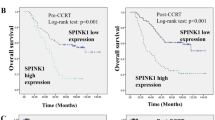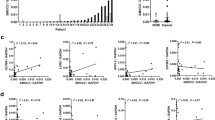Abstract
Serine protease inhibitor Kazal type-1 (SPINK1), a trypsin kinase inhibitor, is involved in inflammation, cell proliferation and carcinogenesis. The role and association between SPINK1, EGFR and Ki-67 in colorectal adenoma (CRA) and colorectal cancer (CRC) are still unknown. In this study, we used immunohistochemical stain to evaluate expression of SPINK1, EGFR and Ki-67 proteins in 30 CRA and 53 CRC patients semiquantitatively, and then analyzed their correlation with clinicopathologic parameters. Our results revealed that SPINK1 expression was noted in the upper and basal parts of the crypts in CRA and was more intensely related with cellular atypia. EGFR expression was found in 13 out of 30 adenomas, including 9 out of 15 adenomas with dysplasia or synchronous CRC (60 %), and 4 out of 15 adenomas without dysplasia (26.7 %). In CRC, high SPINK1 expression was significantly associated with males (p = 0.041) and advanced disease stage (p = 0.015). EGFR positivity was significantly correlated with higher T stage (p = 0.004) and disease stage (stage I-IV, p = 0.017; early vs. late, p = 0.015). Pearson’s correlation showed positive correlation between the SPINK1 intensity and EGFR immunoreactivity (p = 0.011), and Ki-67 and SPINK1 intensity or percentage (p = 0.017 and p = 0.039 respectively). In Kaplan-Meier analyses, patients with high SPINK1 intensity tended to have shorter overall survival (p = 0.03). Concomitant expression of high SPINK1 intensity and EGFR was also identified as being associated with poor prognosis (p = 0.015). In conclusion, high SPINK1 expression is associated with advanced stage and poor prognosis. There is positive correlation between high SPINK1 expression, EGFR immunoreactivity, and high Ki-67 labeling index. The SPINK1 protein seems to play a role in tumor proliferation and malignant transformation through the EGFR pathway. SPINK1 may serve as a prognostic biomarker in therapeutic targeting in the future.


Similar content being viewed by others
References
Ferlay J, Soerjomataram I, Ervik M (2012) GLOBOCAN: Estimated cancer incidence, mortality and prevalence worldwide in 2012. International Agency for Research on Cancer
Yamaji Y, Mitsushima T, Yoshida H, Watabe H, Okamoto M, Wada R, Ikuma H, Kawabe T, Omata M (2006) The malignant potential of freshly developed colorectal polyps according to age. Cancer Epidemiol Biomarkers Prev 15(12):2418–21
Kazal LA, Spicer DS, Brahinsky RA (1948) Isolation of a crystalline trypsin inhibitor-anticoagulant protein from pancreas. J Am Chem Soc 70(9):3034–40
Masamune A, Mizutamari H, Kume K, Asakura T, Satoh K, Shimosegawa T (2004) Hereditary pancreatitis as the premalignant disease: a Japanese case of pancreatic cancer involving the SPINK1 gene mutation N34S. Pancreas 28(3):305–10
Stenman UH (2011) SPINK1: a new therapeutic target in cancer? Clin Chem 57(11):1474–5
Ateeq B, Tomlins SA, Laxman B, Asangani IA, Cao Q, Cao X, Li Y, Wang X, Feng FY, Pienta KJ, Varambally S, Chinnaiyan AM (2011) Therapeutic targeting of SPINK1-positive prostate cancer. Sci Transl Med 3(72):72ra17
Lenz HJ (2006) Anti-EGFR mechanism of action: antitumor effect and underlying cause of adverse events. Oncology (Williston Park) 20(5 Suppl 2):5–13
Nicholson RI, Gee JM, Harper ME (2001) EGFR and cancer prognosis. Eur J Cancer 37(Suppl 4):S9–15
Vokes EE, Chu E (2006) Anti-EGFR therapies: clinical experience in colorectal, lung, and head and neck cancers. Oncology (Williston Park) 20(5 Suppl 2):15–25
Fukuoka S, Fushiki T, Kitagawa Y, Sugimoto E, Iwai K (1987) Competition of a growth stimulating-/cholecystokinin (CCK) releasing-peptide (monitor peptide) with epidermal growth factor for binding to 3T3 fibroblasts. Biochem Biophys Res Commun 145(2):646–50
Ozaki N, Ohmuraya M, Hirota M, Ida S, Wang J, Takamori H, Higashiyama S, Baba H, Yamamura K (2009) Serine protease inhibitor Kazal type 1 promotes proliferation of pancreatic cancer cells through the epidermal growth factor receptor. Mol Cancer Res 7(9):1572–81
Ozaki N, Ohmuraya M, Ida S, Hashimoto D, Ikuta Y, Chikamoto A, Hirota M, Baba H (2013) Serine protease inhibitor Kazal type 1 and epidermal growth factor receptor are expressed in pancreatic tubular adenocarcinoma, intraductal papillary mucinous neoplasm, and pancreatic intraepithelial neoplasia. J Hepatobiliary Pancreat Sci
Scholzen T, Gerdes J (2000) The Ki-67 protein: from the known and the unknown. J Cell Physiol 182(3):311–22
Edge SB, Byrd DR, Compton CC (2010) American Joint Committee on Cancer (AJCC) Cancer Staging Manual, 7th edn. Springer, New York
Rink M, Park K, Volkmer BG, Xylinas E, Hansen J, Cha EK, Robinson BD, Hautmann R, Kufer R, Engel O, Chun FK, Dahlem R, Rubin MA, Shariat SF, Mosquera JM (2012) Loss of SPINK1 expression is associated with unfavorable outcomes in urothelial carcinoma of the bladder after radical cystectomy. Urol Oncol
Koskensalo S, Hagstrom J, Louhimo J, Stenman UH, Haglund C (2012) Tumour-associated trypsin inhibitor TATI is a prognostic marker in colorectal cancer. Oncology 82(4):234–41
Gaber A, Johansson M, Stenman UH, Hotakainen K, Ponten F, Glimelius B, Bjartell A, Jirstrom K, Birgisson H (2009) High expression of tumour-associated trypsin inhibitor correlates with liver metastasis and poor prognosis in colorectal cancer. Br J Cancer 100(10):1540–8
Atkins D, Reiffen KA, Tegtmeier CL, Winther H, Bonato MS, Storkel S (2004) Immunohistochemical detection of EGFR in paraffin-embedded tumor tissues: variation in staining intensity due to choice of fixative and storage time of tissue sections. J Histochem Cytochem 52(7):893–901
Allegra CJ, Paik S, Colangelo LH, Parr AL, Kirsch I, Kim G, Klein P, Johnston PG, Wolmark N, Wieand HS (2003) Prognostic value of thymidylate synthase, Ki-67, and p53 in patients with Dukes’ B and C colon cancer: a National Cancer Institute-National Surgical Adjuvant Breast and Bowel Project collaborative study. J Clin Oncol 21(2):241–50
Fluge O, Gravdal K, Carlsen E, Vonen B, Kjellevold K, Refsum S, Lilleng R, Eide TJ, Halvorsen TB, Tveit KM, Otte AP, Akslen LA, Dahl O (2009) Expression of EZH2 and Ki-67 in colorectal cancer and associations with treatment response and prognosis. Br J Cancer 101(8):1282–9
Peng Y, Wang L, Gu J (2013) Elevated preoperative carcinoembryonic antigen (CEA) and Ki67 is predictor of decreased survival in IIA stage colon cancer. World J Surg 37(1):208–13
Ohmachi Y, Murata A, Matsuura N, Yasuda T, Uda K, Mori T (1994) Overexpression of pancreatic secretory trypsin inhibitor in pancreatic cancer. Evaluation of its biological function as a growth factor. Int J Pancreatol 15(1):65–73
Paju A, Hotakainen K, Cao Y, Laurila T, Gadaleanu V, Hemminki A, Stenman UH, Bjartell A (2007) Increased expression of tumor-associated trypsin inhibitor, TATI, in prostate cancer and in androgen-independent 22Rv1 cells. Eur Urol 52(6):1670–9
Bohe H, Bohe M, Lindstrom C, Ohlsson K (1990) Immunohistochemical demonstration of pancreatic secretory trypsin inhibitor in normal and neoplastic colonic mucosa. J Clin Pathol 43(11):901–4
Higashiyama M, Monden T, Tomita N, Murotani M, Kawasaki Y, Morimoto H, Murata A, Shimano T, Ogawa M, Mori T (1990) Expression of pancreatic secretory trypsin inhibitor (PSTI) in colorectal cancer. Br J Cancer 62(6):954–8
Gaber A, Nodin B, Hotakainen K, Nilsson E, Stenman UH, Bjartell A, Birgisson H, Jirstrom K (2010) Increased serum levels of tumour-associated trypsin inhibitor independently predict a poor prognosis in colorectal cancer patients. BMC Cancer 10(498
Gouyer V, Fontaine D, Dumont P, de Wever O, Fontayne-Devaud H, Leteurtre E, Truant S, Delacour D, Drobecq H, Kerckaert JP, de Launoit Y, Bracke M, Gespach C, Desseyn JL, Huet G (2008) Autocrine induction of invasion and metastasis by tumor-associated trypsin inhibitor in human colon cancer cells. Oncogene 27(29):4024–33
Marchbank T, Mahmood A, Playford RJ (2013) Pancreatic secretory trypsin inhibitor causes autocrine-mediated migration and invasion in bladder cancer and phosphorylates the EGF receptor, Akt2 and Akt3, and ERK1 and ERK2. Am J Physiol Renal Physiol 305(3):F382–9
Gaber A, Stene C, Hotakainen K, Nodin B, Palmquist I, Bjartell A, Stenman UH, Jeppsson B, Johnson LB, Jirstrom K (2011) Effects of radiation therapy on tissue and serum concentrations of tumour associated trypsin inhibitor and their prognostic significance in rectal cancer patients. Radiat Oncol 6(100
Rego RL, Foster NR, Smyrk TC, Le M, O’Connell MJ, Sargent DJ, Windschitl H, Sinicrope FA (2010) Prognostic effect of activated EGFR expression in human colon carcinomas: comparison with EGFR status. Br J Cancer 102(1):165–72
Zhang W, Gordon M, Lenz HJ (2006) Novel approaches to treatment of advanced colorectal cancer with anti-EGFR monoclonal antibodies. Ann Med 38(8):545–51
Bansal A, Liu X, McGregor DH, Singh V, Hall S (2010) Correlation of epidermal growth factor receptor with morphological features of colorectal advanced adenomas: a pilot correlative case series. Am J Med Sci 340(4):296–300
Rokita M, Stec R, Bodnar L, Charkiewicz R, Korniluk J, Smoter M, Cichowicz M, Chyczewski L, Niklinski J, Kozlowski W, Szczylik C (2013) Overexpression of epidermal growth factor receptor as a prognostic factor in colorectal cancer on the basis of the Allred scoring system. Onco Targets Ther 6(967-76)
Roberts RB, Min L, Washington MK, Olsen SJ, Settle SH, Coffey RJ, Threadgill DW (2002) Importance of epidermal growth factor receptor signaling in establishment of adenomas and maintenance of carcinomas during intestinal tumorigenesis. Proc Natl Acad Sci U S A 99(3):1521–6
Ogawa M, Tsushima T, Ohba Y, Ogawa N, Tanaka S, Ishida M, Mori T (1985) Stimulation of DNA synthesis in human fibroblasts by human pancreatic secretory trypsin inhibitor. Res Commun Chem Pathol Pharmacol 50(1):155–8
Koskensalo S, Louhimo J, Hagstrom J, Lundin M, Stenman UH, Haglund C (2013) Concomitant tumor expression of EGFR and TATI/SPINK1 associates with better prognosis in colorectal cancer. PLoS One 8(10), e76906
Grondahl-Hansen J, Christensen IJ, Rosenquist C, Brunner N, Mouridsen HT, Dano K, Blichert-Toft M (1993) High levels of urokinase-type plasminogen activator and its inhibitor PAI-1 in cytosolic extracts of breast carcinomas are associated with poor prognosis. Cancer Res 53(11):2513–21
Schrohl AS, Holten-Andersen MN, Peters HA, Look MP, Meijer-van Gelder ME, Klijn JG, Brunner N, Foekens JA (2004) Tumor tissue levels of tissue inhibitor of metalloproteinase-1 as a prognostic marker in primary breast cancer. Clin Cancer Res 10(7):2289–98
Acknowledgments
This work was supported by a grant from Ministry of Health and Welfare (MOHW103-TD-B-111-05) and Kaohsiung Medical University Research Foundation (KMU-M103013).
Author information
Authors and Affiliations
Corresponding author
Rights and permissions
About this article
Cite this article
Chen, YT., Tsao, SC., Yuan, SS.F. et al. Serine Protease Inhibitor Kazal Type 1 (SPINK1) Promotes Proliferation of Colorectal Cancer Through the Epidermal Growth Factor as a Prognostic Marker. Pathol. Oncol. Res. 21, 1201–1208 (2015). https://doi.org/10.1007/s12253-015-9949-0
Received:
Accepted:
Published:
Issue Date:
DOI: https://doi.org/10.1007/s12253-015-9949-0




